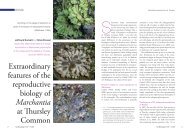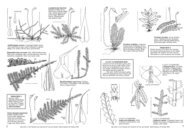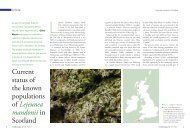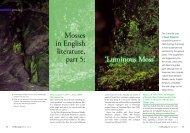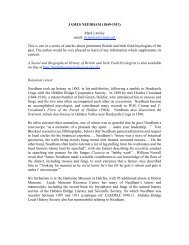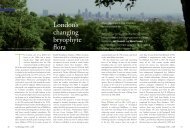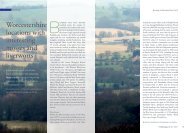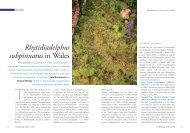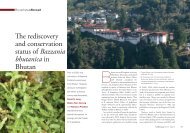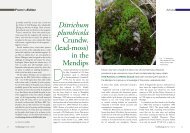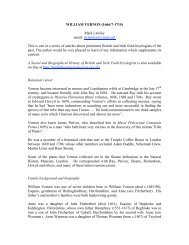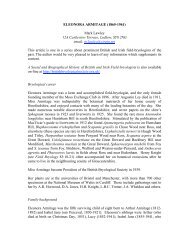Bryological Monograph An annotated checklist of the mosses of ...
Bryological Monograph An annotated checklist of the mosses of ...
Bryological Monograph An annotated checklist of the mosses of ...
You also want an ePaper? Increase the reach of your titles
YUMPU automatically turns print PDFs into web optimized ePapers that Google loves.
usual non-fertile plants would be impossible to name<br />
with certainty. However, European bryologists have<br />
long recognized A. concinnatum without great<br />
difficulty from non-fertile material, so this form is<br />
surely best treated at species rank as advocated by<br />
Loeske.<br />
266. Sérgio, Cros & Brugués (1996) re-examined <strong>An</strong>omobryum<br />
lusitanicum in detail, retaining it in <strong>the</strong> genus<br />
<strong>An</strong>omobryum.<br />
267. Brachymenium commutatum is known in Europe only<br />
from <strong>the</strong> Sierra Nevada. It was first reported by<br />
Thériot (1932) as B. commutatum var. hispanicum<br />
Thér. and rediscovered in 1997 (Brugués et al., 2003).<br />
European plants are sterile and less robust than var.<br />
attenuatum Thér. & Trab., which was described from<br />
<strong>the</strong> Hoggar mountains, Algeria. Small forms are also<br />
found in <strong>the</strong> Hoggar (Thériot, 1932). Ochi (1972,<br />
1973) did not examine any <strong>of</strong> <strong>the</strong> type material <strong>of</strong> B.<br />
commutatum during his review <strong>of</strong> African Bryoideae.<br />
However, a specimen assigned to B. commutatum var.<br />
attenuatum from Sudan and material from Eritrea<br />
were reidentified by him as <strong>the</strong> widespread B. exile<br />
Dozy & Molk. It appears very likely that B.<br />
commutatum should be placed as a synonym <strong>of</strong> B.<br />
exile.<br />
268. Brachymenium notarisii was placed in <strong>the</strong> genus<br />
Haplodontium for many years, within which it is <strong>the</strong><br />
type <strong>of</strong> subgenus Ateleobryum (Mitt.) Broth. (Wijk,<br />
Margadant & Florschütz, 1962). It was transferred<br />
from Haplodontium to Brachymenium by Shaw (1987),<br />
who commented that ‘it certainly does not belong in<br />
<strong>the</strong> Mielichh<strong>of</strong>erioideae’.<br />
269. Podpěra (1954) identified Mielichh<strong>of</strong>eria paradoxa<br />
with ‘Bryum splachnoides C. M.’, i.e. B. cellulare.<br />
However, Shaw (1987) reidentified it as a distinct<br />
species known only from Macedonia that he placed in<br />
Brachymenium, an arrangement that was followed by<br />
Corley et al. (1991). The recent <strong>checklist</strong> <strong>of</strong> <strong>mosses</strong> <strong>of</strong><br />
<strong>the</strong> former Yugoslavia (Pavletic, Martincic & Düll,<br />
1999) continues to treat Brachymenium paradoxum<br />
erroneously as Bryum cellulare.<br />
270. Brachymenium philonotula is known in our area only<br />
from Madeira (Rocha da Pena, 1928, leg. C. Barreto,<br />
S). According to Ochi (1972) it is perhaps conspecific<br />
with B. exile Dozy & Molk.<br />
271. Bryum pamirense H.Philib. ex Broth. was reported<br />
new for Europe from Komi Republic in nor<strong>the</strong>rn<br />
Russia (Zheleznova & Shubina, 1998). However,<br />
Ignatov & Afonina (1992) marked it with ?, to denote<br />
a ‘particularly poorly known and putatively ill-defined<br />
species’. Bryum pamirense is apparently close to B.<br />
savicziae and B. uliginosum (Savicz-Ljubitzkaja &<br />
Smirnova, 1970), but differs from both <strong>of</strong> <strong>the</strong>se in<br />
being synoicous ra<strong>the</strong>r than autoicous. Like B.<br />
savicziae, it has <strong>the</strong> cilia <strong>of</strong> <strong>the</strong> endostome well<br />
developed and appendiculate, whereas B. uliginosum<br />
MOSSES OF EUROPE AND MACARONESIA 237<br />
has short cilia. It might be a form <strong>of</strong> B. uliginosum or<br />
possibly a hybrid.<br />
272. Bryum savicziae Schljakov was described from <strong>the</strong><br />
Kola peninsula in Russia in 1951 but overlooked by<br />
Index Muscorum (Wijk, Margadant & Florschütz,<br />
1959, 1969). It is known only from <strong>the</strong> type-locality. It<br />
resembles B. uliginosum but has <strong>the</strong> cilia <strong>of</strong> <strong>the</strong><br />
endostome well developed and appendiculate. Spore<br />
sizes <strong>of</strong> 19–31 mm given by Savicz-Ljubitzkaja &<br />
Smirnova (1970) seem ra<strong>the</strong>r variable and perhaps<br />
this suggests a hybrid is involved. Ignatov & Afonina<br />
(1992) also reported B. ekstamii L.I.Savicz, B.<br />
labradorense H.Philib., B. umbratum I.Hagen and B.<br />
zemliae Arnell & Jaderh. from <strong>the</strong> north <strong>of</strong> European<br />
Russia. These little-known species require fur<strong>the</strong>r<br />
study.<br />
273. Bryum vermigerum Arnell & C.E.O.Jensen was<br />
discovered at Hardanger, Norway in 1915 and<br />
1916; it is o<strong>the</strong>rwise known only by a recent report<br />
from Iceland. Bryum vermigerum was treated as a<br />
valid species by Nyholm (1993) and its combination<br />
<strong>of</strong> characters is undoubtedly different from that in<br />
any o<strong>the</strong>r European Bryum species. Never<strong>the</strong>less,<br />
Nyholm reported an extraordinarily wide range <strong>of</strong><br />
spore sizes (10–20 mm) and, although one capsule<br />
examined by Holyoak (at S) contained spores <strong>of</strong><br />
less variable size (10–14 mm), <strong>the</strong>se included a<br />
proportion <strong>of</strong> small shrunken and presumably<br />
abortive spores. The rarity <strong>of</strong> B. vermigerum, its<br />
peculiar characters and <strong>the</strong> variable and sometimes<br />
abortive spores may suggest that an interspecific<br />
hybrid is involved.<br />
274. Bryum colombii Meyl. and B. mesodon J.J.Amann are<br />
listed in <strong>the</strong> current Swiss list http://www.bryolich.ch/,<br />
but <strong>the</strong>ir identity is uncertain. Bryum murmanicum<br />
Broth. is on <strong>the</strong> Red List for <strong>the</strong> Murmansk Oblast <strong>of</strong><br />
Russia as Data Deficient; its identity is also uncertain.<br />
Bryum geheebii Müll.Hal. was treated as probably a<br />
synonym <strong>of</strong> B. alpinum by Corley et al. (1981), as a<br />
species by Düll (1985), but very doubtful by Düll<br />
(1992); its identity is uncertain. The identity <strong>of</strong> B. teres<br />
Lindb. is also uncertain; it was treated by Düll (1985)<br />
as a synonym <strong>of</strong> B. nitidulum (here treated as a<br />
synonym <strong>of</strong> B. intermedium), but this synonymy was<br />
questioned by Nyholm (1993).<br />
275. Bryum gerwigii (Müll.Hal.) Limpr. is known from its<br />
type-locality on limestone rocks above <strong>the</strong> Rheinfalles<br />
near Schaffhausen in Switzerland and from a few<br />
o<strong>the</strong>r reports from central Europe. As with o<strong>the</strong>r<br />
submerged Bryum, it is apparently so greatly modified<br />
by growth in water (and perhaps by low light levels)<br />
that it is difficult to judge which species was its<br />
immediate progenitor. This uncertainty provides<br />
insufficient reason for treating it as a valid species.<br />
Bryum gemmiparum seems closest in view <strong>of</strong> <strong>the</strong> leaf<br />
shape, occurrence <strong>of</strong> bulbils and <strong>the</strong> habitat.



